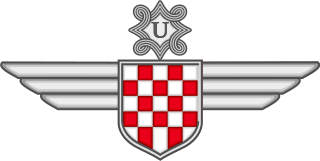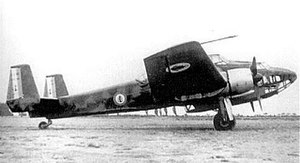
The German aircraft carrier Graf Zeppelin was the lead ship in a class of two carriers of the same name ordered by the Kriegsmarine of Nazi Germany. She was the only aircraft carrier launched by Germany and represented part of the Kriegsmarine's attempt to create a well-balanced oceangoing fleet, capable of projecting German naval power far beyond the narrow confines of the Baltic and North Seas. The carrier would have had a complement of 42 fighters and dive bombers.

The Fairey Albacore is a single-engine biplane torpedo bomber designed and produced by the British aircraft manufacturer Fairey Aviation. It was primarily operated by the Royal Navy Fleet Air Arm (FAA) during the Second World War.

The Arado Ar 197 was a German World War II-era biplane, designed for naval operations for the never-completed German aircraft carrier Graf Zeppelin. Only a few prototypes were built; the project was abandoned in favour of the Messerschmitt Bf 109T and Me 155.

The Fieseler Fi 98 was a prototype ground-attack aircraft produced by German aircraft manufacturer Fieseler as a rival to the Henschel Hs 123.

The Yokosuka B4Y was a carrier-borne torpedo bomber used by the Imperial Japanese Navy Air Service from 1936 to 1943. The B4Y replaced the Mitsubishi B2M2 and was the last biplane bomber used operationally by the Imperial Japanese Navy. The Allied reporting name was "Jean".

The Mitsubishi B2M was a Japanese carrier-based torpedo bomber of the 1920s and 1930s. It was built by Mitsubishi to a design by Blackburn Aircraft of Britain and was operated by the Imperial Japanese Navy.

The Arado Ar 95 was a single-engine reconnaissance and patrol biplane designed and produced by the German aircraft manufacturer Arado.

The Arado Ar 195 was a single-engine prototype carrier-based torpedo bomber, built by the German firm Arado for service on the German aircraft carrier Graf Zeppelin, during World War II.

The Graf Zeppelin-class aircraft carriers were four German Kriegsmarine aircraft carriers planned in the mid-1930s by Grand Admiral Erich Raeder as part of the Plan Z rearmament program after Germany and Great Britain signed the Anglo-German Naval Agreement. They were planned after a thorough study of Japanese carrier designs. German naval architects ran into difficulties due to lack of experience in building such vessels, the situational realities of carrier operations in the North Sea and the lack of overall clarity in the ships' mission objectives.

The Air Force of the Independent State of Croatia, was the air force of the Independent State of Croatia (NDH), a puppet state established with the support of the Axis Powers on the territory of the Kingdom of Yugoslavia during World War II. The ZNDH was founded under German authority in April 1941, following the German-led Axis invasion of Yugoslavia.

The Croatian Air Force Legion, or HZL, was a unit of the Luftwaffe, composed entirely of volunteers drawn from the nazi puppet-state, the Independent State of Croatia. Many of them had previously served in the Royal Yugoslav Air Force in April 1941 during the Nazi Invasion of Yugoslavia.

The Arado Ar 81 was a German prototype dive bomber. Because the Reich Air Ministry decided to purchase the competing Junkers Ju 87, only three prototypes of the Ar 81 were completed.
Air warfare during World War II in Yugoslavia pitted the Yugoslav Air Force, both Royal and NOVJ, United States Army Air Force (USAAF), the Royal Air Force (RAF), including the Balkan Air Force, and Soviet Air Forces against the German Luftwaffe, the Italian Regia Aeronautica and the Air Force of the Independent State of Croatia. The latter provided the majority of the support for the ground operations against the Partisans. The Allied forces engaged in an extensive bombing campaign in an effort to weaken the Axis hold on the country.
This article details the history of the Croatian Air Force. The Republic of Croatia is a unitary democratic parliamentary republic in Europe at the crossroads of Central Europe, the Mediterranean, and the Southeast Europe. Its capital and largest city is Zagreb. The modern Croatian Air Force was established on 12 December 1991, during the Croatian War of Independence.

The SNCAO CAO.600 was a French prototype twin-engined torpedo-bomber of the Second World War. It was intended to operate from two new aircraft carriers of the French Navy, but only a single example had been completed and flown when the surrender of France in June 1940 ended development of the aircraft.
Waldau Army Airfield is a former military airfield, located 4.0 km south of Kassel in Hesse, Germany.












